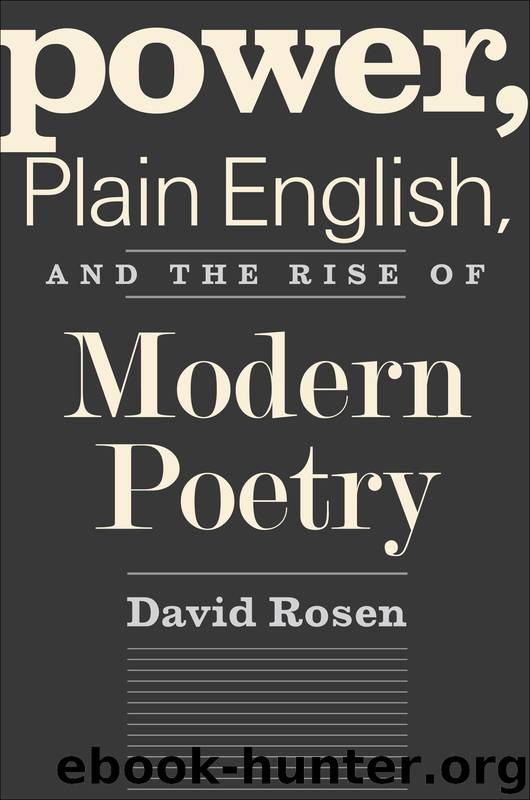Power, Plain English, and the Rise of Modern Poetry by Rosen David

Author:Rosen, David
Language: eng
Format: epub
Publisher: Yale University Press
Published: 2003-04-14T16:00:00+00:00
THE LATE STYLE: “A PRAYER FOR MY
DAUGHTER”; “MAN AND THE ECHO”
Yeats’s poetry during these last two decades, not surprisingly, is linguistically his most subtle and complex, as various registers low and high—visionary, traditional, drab and plain, as well as grand and oratorical—are played against each other in extremely intricate ways. His work in these years resembles Wordsworth’s after 1803, after the sweeping entry of Latinate diction into Wordsworth’s vocabulary. The resemblance is not coincidental: the early nineteenth century witnessed Wordsworth’s attempts to write public-minded, meaningful poetry while retaining the power of his first major lyrics; the strain of these efforts shows in poems—the political sonnets and, above all, “Michael”—that hold together multiple registers in unstable suspension. Yeats’s endeavors are not very different; after Responsibilities—the Nobel Prize in 1923 does not discourage him—he conceives of himself as a national poet, expected to speak on Irish issues. This change in attitude is itself part of a larger change more germane to our subject: both his radical separation of power and meaning and his privileging of the former over the latter, so useful in extricating himself from his crisis, are of less value to Yeats after he has found success. As he lets the several quarters of his persona coalesce, the strains of language associated with those parts coalesce as well. His work in this period, also not surprisingly, is most often selected by critics who would label him a propagandist. Such hostility is doubtless a response to his politics, which, right-wing to begin with, are colored increasingly by an attraction to Fascism.40 It might be argued, however, that his late style, regardless of ideological shading, is inevitably tendentious. Where the mixing of registers in Wordsworth is an honest mistake, as it were, the Yeats of 1919–1939 is remarkably clear-eyed about violating the separation between his social and visionary sides. Thus, perhaps, our sense, reading even his most neutral work of the period, that Yeats has a palpable design on us. At all events, his style and politics prove well-suited for each other.
“A Prayer for My Daughter” (1919) may have the distinction of being Yeats’s most hated major poem. Reactions to it range from the tactful silence of Yeats sympathizers (Ellmann, Norman Jeffares, Elizabeth Cullingford), to the polite contempt of Bloom (“We all have . . . poems we greatly admire but dislike”), to outright excoriation. It offers a laundry list of unpopular views, but has been most attacked for its view of women. In Marjorie Howes’s assessment, it “depicts the Anglo-Irish as . . . a tradition whose continuity is both dependent on and threatened by female sexual choice”; Yeats “offers an obviously sexist prescription for his daughter’s future life and development.”41 These observations are doubtless accurate; but for the moment, I am more interested in how Yeats persuades than in any views he might hold. Since I will be analyzing the poem at length, I give it in its entirety.
A Prayer for My Daughter
Once more the storm is howling, and half hid
Under this cradle-hood and coverlid
My child sleeps on.
Download
This site does not store any files on its server. We only index and link to content provided by other sites. Please contact the content providers to delete copyright contents if any and email us, we'll remove relevant links or contents immediately.
Still Me by Jojo Moyes(9908)
On the Yard (New York Review Books Classics) by Braly Malcolm(5159)
A Year in the Merde by Stephen Clarke(4655)
Eleanor Oliphant Is Completely Fine by Gail Honeyman(4640)
The Bookshop by Penelope Fitzgerald(3230)
Surprise Me by Kinsella Sophie(2755)
Pharaoh by Wilbur Smith(2647)
How Music Works by David Byrne(2528)
Why I Write by George Orwell(2360)
A Column of Fire by Ken Follett(2179)
The Beach by Alex Garland(2142)
The Songlines by Bruce Chatwin(2112)
Aubrey–Maturin 02 - [1803-04] - Post Captain by Patrick O'Brian(2020)
Churchill by Paul Johnson(2013)
Heartless by Mary Balogh(1955)
Elizabeth by Philippa Jones(1858)
Hitler by Ian Kershaw(1754)
The Patrick Melrose Novels by Edward St. Aubyn(1709)
Harry Potter and the Cursed Child by J. K. Rowling & John Tiffany & Jack Thorne(1693)
